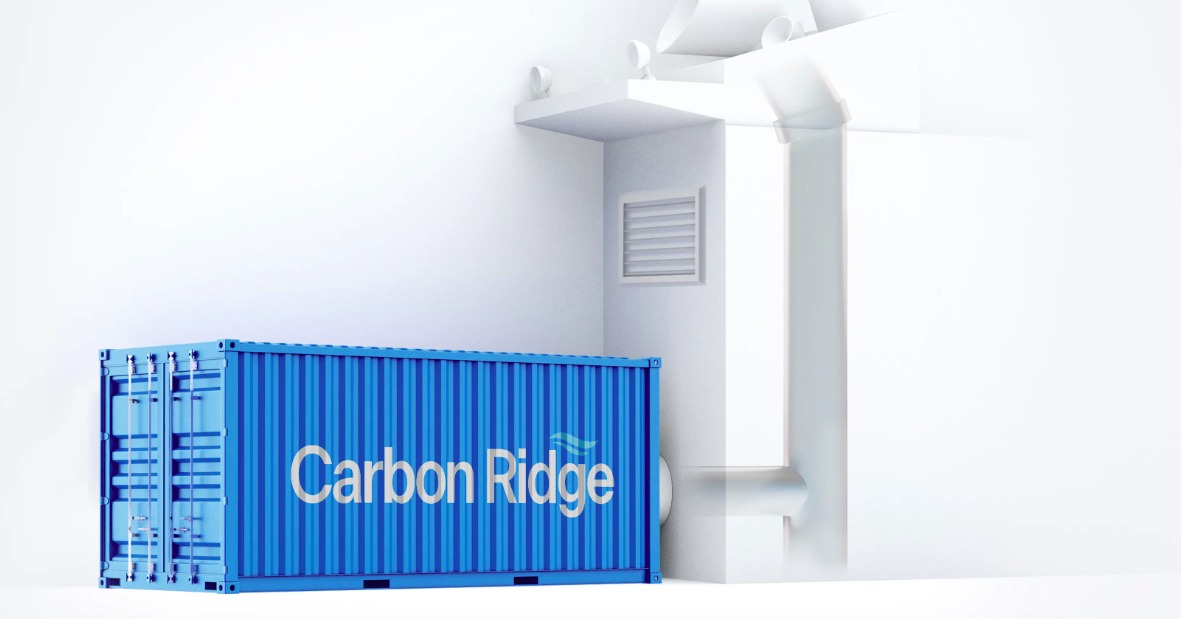Although the technology might seem fairly archaic by 21st century standards, 90 percent of all international global freight is still shipped by sea. As a result, the maritime cargo industry produces around 940 million tonnes of carbon a year – around 2.5 percent of the global total. Researchers suspect this will increase to 10 percent by 2050.
Reducing or decarbonising maritime freight is therefore an important goal to create a carbon free world. Various different methods are being developed to achieve this, but one emerging concept is the use of onboard carbon capture and storage (OCCS).
As the name suggests, OCCS applies carbon capture technology – often used on land-based factories – to moving ships. One Los Angeles-based developer, Carbon Ridge, suggests the concept is not only affordable but non-invasive and potentially lucrative.
In their system, shipping containers of carbon capture equipment are installed adjacent to a ship’s exhaust funnel. Exhaust gas from the engine is intercepted by the Carbon Ridge system where the carbon dioxide and other gases are separated via a system of compression and liquificiation. The decarbonised exhaust fumes can then be released as per normal via the funnel, while the carbon is stored within shipping containers in a solid form.
Once at port, this carbon can be offloaded and either permanently sequestered or stored, or used to produce new products. Carbon Ridge also monetises the credits awarded for every ton of CO2 captured on commercial markets.
Carbon Ridge suggests their system can be easily, and with only minor modifications, added to most models of cargo ships – and at an affordable cost. They also claim their model is around 75 percent smaller than other OCCS systems and has been specifically developed to operate within maritime conditions. Ultimately, Carbon Ridge suggests a ship’s overall carbon footprint could be reduced by as much as 95 percent by using their system.
Of course, carbon capture does come with some concerns, notably what do you do with the carbon once you’ve captured it. In some cases, the carbon can be used to produce new products, such as fuels or building materials. Otherwise, it can also be stored deep underground in various geological formations. Former gas and oil reservoirs are popular choices, since they have already held gas or oil for millions of years. Other options include saline reservoirs, coal beds, basalt formations and shale basins.
Decarbonising Cargo
However, carbon capture is only one option for decarbonising freight and shipping. Another approach harks back to the age of sail of bygone centuries. Several startups and companies are working to develop wind-powered generators for large cargo ships. Several different designs have been suggested, including rotating pillars and kites mounted on the bow of a ship. These turbines can then be used to partially power a ship, reducing its dependence on oil fuels.
Other methods include creating new AI-powered platforms which can more efficiently plan shipping routes. Long distances, high speed and choppy seas can all increase the amount of fuel expended and carbon created. By creating more efficient routes, ships can reduce their speeds and fuel expenditure, potentially making large carbon savings.
Ultimately, the most effective methods for decarbonising cargo will be those which also make economic sense to the shipping companies. As a recent report suggested, fossil fuels are not as cheap as often perceived, while renewable power sources are becoming cheaper year upon year. Anything which can reliably reduce fuel costs without compromising schedules or capacity could become attractive to shipping companies who live or die by the balance sheet.
The post Is Onboard Carbon Capture the Way Forward for Cleaner Cargo? appeared first on Digital for Good | RESET.ORG.


